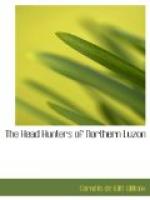“As the pig was being put in the pot to be cooked for the old men who had performed the feast, some unmannerly young fellow started to make away with one piece of the flesh. Immediately there was a scramble which was joined by some three or four hundred Ifugaos of all the different rancherias. Then the feasters (I think there were about one thousand who attended the feast) leaped for their spears and shields. The people who had come from Kiangan rushed to where I was and took their stand in front of and around me, and told me to stay there and that they would protect me from any harm; all of which, as may well be supposed, produced no trifling amount of warmth in my feelings toward them. Fortunately nothing came of the scramble.
“I have no hesitancy in saying that two or three years ago, before Governor Gallman had performed his excellent and truly wonderful work among the Ifugaos, this scramble would have become a fight in which somebody would have lost his life. That such a thing could take place without danger was incomprehensible to the old women of Kiangan, who doubtless remembered sons or husbands, brothers or cousins, who had lost their lives in such an affair. With the memory of these old times in their minds they caught me by the arms and by the waist and said, ’Barton, come home; we don’t know the mind of the people; they are likely to kill you.’ When I refused to miss seeing the rest of the feast, they told me to keep my revolver ready.
“Looking back on this incident, I am sure that I was in little, I believe no danger, but must give credit to my Ifugao boy who attended me in having the wisest head in the party. This boy immediately thought of my horse, which was picketed near, and ran to it, taking with him one or two responsible Kiangan men to help him watch and defend it. Had he not done so, some meat-hungry, hot-headed Ifugao might easily have stuck a bolo in his side during the scramble and its confusion; and immediately some five hundred or more Ifugaos would have been right on top of the carcase, hand-hacking at it with their long war-knives, and it would probably have been impossible ever to find out who gave the first thrust.




